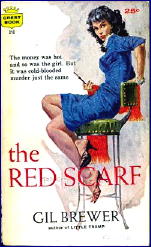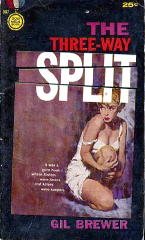Sat 11 Jul 2009
A 1001 MIDNIGHTS review: GIL BREWER – The Red Scarf.
Posted by Steve under 1001 Midnights , ReviewsNo Comments
by Bill Pronzini:
GIL BREWER – The Red Scarf. Mystery House, hardcover, 1958. Paperback reprint: Crest 310; 1st printing, July 1959. First published in Mercury Mystery Book-Magazine, November 1955 (quite likely in shortened form).

Motel owner Ray Nichols, hitchhiking home in northern Florida after a futile trip up north to raise capital for his floundering auto court, is given a ride by a bickering and drunken couple named Vivian Rise and Noel Teece.
An accident, the result of Teece’s drinking, leaves Teece bloody and unconscious. Unhurt, Nichols finds a suitcase full of money in the car. Vivian, also unhurt, urges that they leave with it together before the police come, saying it belongs to her and offering to pay Nichols for his help. Against his better judgment, he agrees.
It is only later, back home in the town of Lakeview, that Nichols discovers Teece is a courier for an underworld gambling syndicate and that the money really belongs to them. While he struggles with his conscience, several groups begin vying for the loot, including a syndicate man named Wirt Radan, the police — and Teece. Nichols and his wife, Bess, soon become targets, and Brewer leads us through a couple of neat plot turns on the way to a volatile climax.

There is considerable suspense here, some strong characterization, and the various components mesh smoothly. Brewer’s prose is leaner and more controlled than in any of his other novels.
Anthony Boucher said in the New York Times that The Red Scarf is the “all-around best Gil Brewer … a full-packed story.” This reviewer agrees.
Nearly all of Brewer’s thirty other novels (all but one of which, are paperback originals) are worth reading. Especially good are And the Girl Screamed (1956), which has some fine chase sequences; The Angry Dream (1957), the second of Brewer’s two hardcovers and a tale of hatred out of the past, in a wintry northern setting; and The Three-Way Split (1960), a well-done story of charter boats and sunken treasure in a style reminiscent of Hemingway’ s To Have and Have Not.
———
Reprinted with permission from 1001 Midnights, edited by Bill Pronzini & Marcia Muller and published by The Battered Silicon Dispatch Box, 2007. Copyright © 1986, 2007 by the Pronzini-Muller Family Trust.